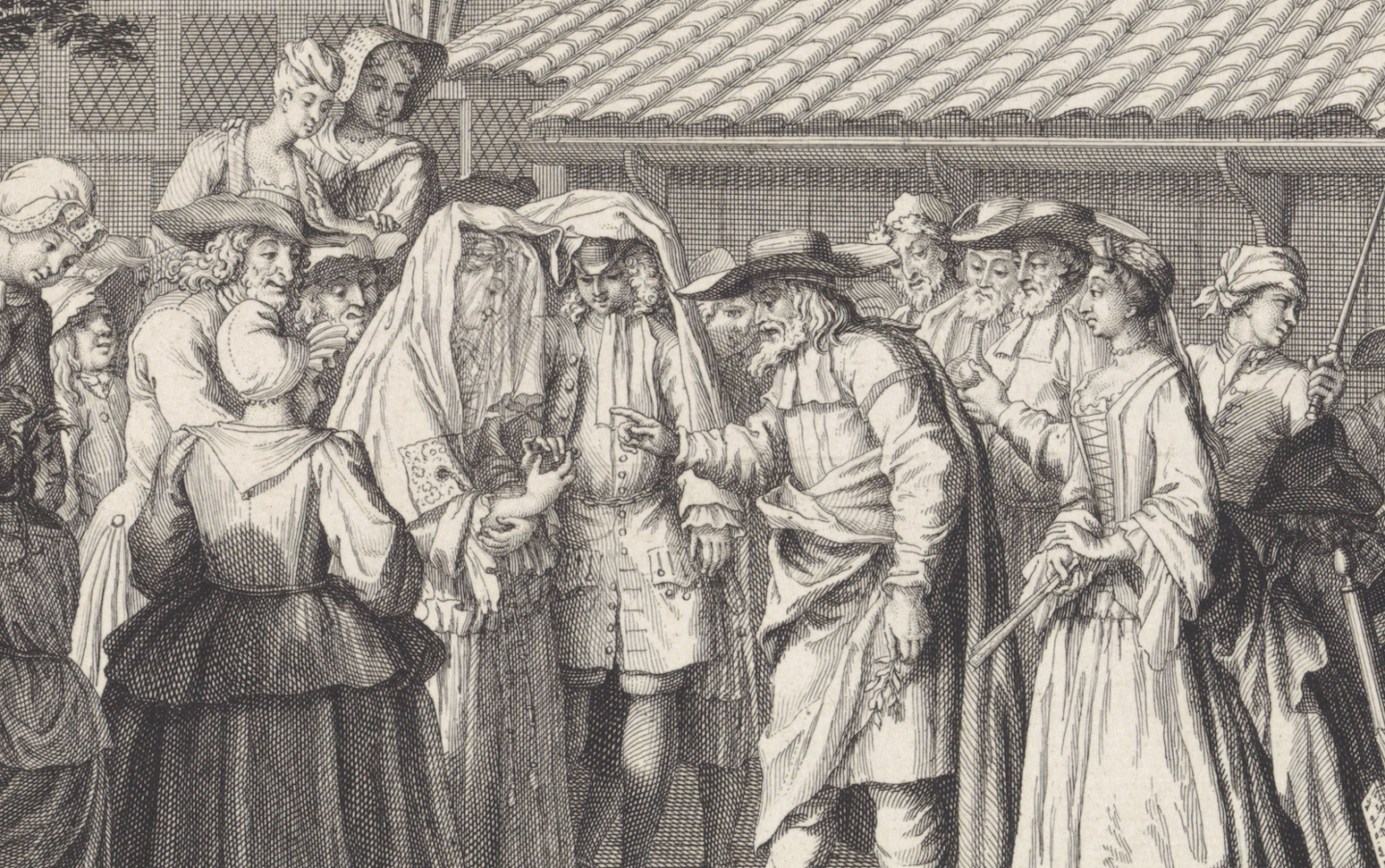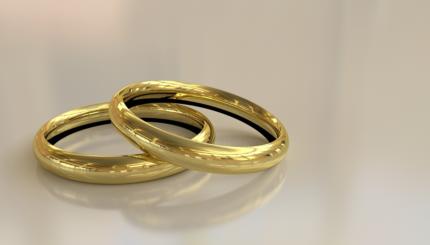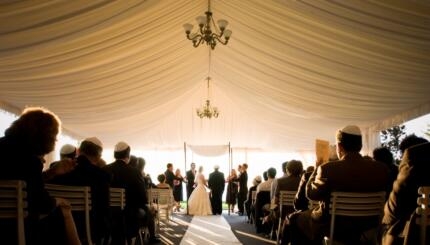The Jewish wedding ceremony comprises two major sections: erusin (betrothal) and nissuin (marriage). When the bride and groom have reached the huppah, the erusin ceremony begins. It is a simple ceremony, marked by two blessings recited by the presiding rabbi, who holds a cup of wine. The first blessing, over wine, is one said at almost all joyous occasions. The second blessing is unique to this occasion and reads as follows:
“Blessed are You, Lord our God, Master of the Universe, Who has sanctified us with His commandments, and commanded us regarding forbidden unions, and Who forbad betrothed women to us, and permitted to us those married to us by huppah and kiddushin. Praised are You, Lord, Who sanctifies His people Israel with huppah and kiddushin.”
After the completion of the second blessing, the rabbi gives the cup of wine to the groom, who drinks of it; the cup is then presented to the bride, who drinks from the same cup, symbolizing their commitment to sharing their lives from that moment on.
What Does the Blessing Mean?
Several crucial themes of the Jewish wedding are expressed in the seemingly simple language of these few lines of this second blessing. First, the liturgical language points to older customs, for in earlier times the Jewish wedding took place in stages over the course of an entire year. At the first ceremony, erusin, the couple were reserved for each other and were forbidden to have relationships with anyone else. But it was not until approximately a year later, at the nissuin ceremony, that they were permitted to consummate their relationship sexually and that the bride moved into the groom’s home.

Help us keep Jewish knowledge accessible to millions of people around the world.
Your donation to My Jewish Learning fuels endless journeys of Jewish discovery. With your help, My Jewish Learning can continue to provide nonstop opportunities for learning, connection and growth.
The language of the second blessing, “who forbad betrothed women to us, and permitted to us those married to us by huppah and kiddushin,” reflects this earlier practice, and apparently served in ancient times as a warning to the couple not to cohabit until the completion of the second ceremony.
Another perhaps more subtle theme emerges from this blessing as well. The language clearly enunciates the central Jewish tenet that marriage is not a private affair but one that affects and involves the entire community. It is not only the couple who are sanctified by their marriage; the sanctification touches the entire people Israel. Why? The marriage of a man and woman tells the community that it has the capacity to survive. Marriage reflects the first union between Adam and Eve, who set not a private stage, but a stage for the playing out of all of human history. Marriage is ultimately a reflection of the survivability of the covenant, and God’s covenant with humanity was made not individually, but collectively. All of this, and more, emerges from the simple words of this blessing.
Formalizing the Marriage With a Ring
At this point in the traditional ceremony, the groom performs the specific act that formalizes the marriage. Today it is customary for the groom to place a ring on the index finger of his bride’s right hand and to recite in Hebrew a phrase that means, “Behold, by this ring you are consecrated to me as my wife according to the laws of Moses and Israel.” Once again, the words “according to the laws of Moses and Israel” suggest the themes of covenant and community, central throughout the ceremony.
This phrasing, now standard in virtually all Jewish communities, was not the only one suggested by the tradition, however. Other known versions include “Behold, you are reserved to me… ” and “according to the laws of Moses and the Jews.”
Instead of a ring, it used to be permissible for the groom to give the bride a detailed deed, and he could then recite the phrase “Behold, you are consecrated to me with the deed…. ” As long as the bride accepted the deed with the intention of becoming his wife, the marriage was valid. Even the act of sexual intercourse was at one point a valid means of marrying a woman. In front of two halakhically acceptable witnesses, a man could say to a woman, “Behold, you are consecrated to me with this [following] act of sexual intercourse according to the laws of Moses and Israel,” whereupon he took her to a private place to consummate their union. Although this process led to a valid marriage, for obvious reasons the sages of the condemned it, calling it prostitution; they insisted that anyone who employed this method of kiddushin should be flogged.
In earlier times, too, various items, including fruits and a prayerbook, could be used to symbolize the betrothal, though today a ring is the most common token. Even so, the nature of that ring is still regulated by Jewish law. It must belong to the groom, and it has to have at least some value, since it substitutes for money that might also have been given to the bride. Tradition requires that the ring not have gems on it, which would make its value difficult for the bride to assess. Similarly, while the ring may be decorated, the decorations should not be cut out of the ring, for the circularity and solidity of the metal suggest the permanence of the relationship now being created.
Egalitarian Approaches to the Ring Ceremony
In recent decades, the bride’s role during the ring ceremony has been much discussed. Should she remain silent and relatively passive, as was the case in the traditional ceremony and continues to be the practice in Orthodox circles, or can she also “betroth” her future husband in some sense?
From the strict point of view of Jewish law, the bride cannot betroth the husband; traditional communities, therefore, do not permit the woman to say to the groom, “Behold, you are consecrated to me…. ” But it is not uncommon, particularly in Conservative circles, for the bride to say something to the groom, usually quoting a biblical verse that speaks of love, relationship, or commitment. In such cases, the bride may also present the groom with a ring, for as the Talmud explains, it is permissible for the bride to give the groom gifts under the huppah.
In liberal Conservative and Reform communities, the concern is less for the strict requirements of Jewish law than for egalitarian treatment of both men and women. In those communities, it is common that the woman places a ring on the man’s finger and recites exactly what he said to her (with the necessary grammatical changes). Some modern Orthodox men, whose communities do not sanction double-ring ceremonies, elect to wear a wedding band after the ceremony, there being no serious traditional objection to this practice.
Using a Borrowed Ring
One additional halakhic [Jewish legal] issue raised by today’s ceremonies deserves mention. We have already noted that because the ring represents an item of value that the groom gives to the bride, Jewish law requires that it belong to him. Many couples, however, wish to use a ring that has been in the family for generations, perhaps a grandmother’s wedding band or some other similarly meaningful heirloom. But if the family member wants the ring back after the ceremony, is this permissible? Can the groom betroth the bride with a ring that is not actually his?
The rather surprising answer is yes. Because of the general halakhic principle that “a gift given with the condition that it be returned is considered a gift,” Jewish law recognizes the ring as belonging to the groom for the duration of the ceremony, and the marriage is valid.
Reading the Ketubah
After the ring ceremony, the [or marriage contract] is read aloud, marking the division between the formerly separated elements of the marriage ritual.
In traditional communities, the entire document is read in the original Aramaic; at most Conservative weddings, the opening and closing sections of the original Aramaic are read, followed by an English translation or paraphrase. The ketubah is then given by the officiating rabbi to the bride, since, at least in the traditional texts, the document enumerates the promises the groom makes to the bride and so becomes her property.
Excerpted with permission from Celebration and Renewal: Rites of Passage in Judaism edited by Rela Mintz Geffen (Jewish Publication Society).



